brakes TOYOTA AURIS 2012 Owners Manual (in English)
[x] Cancel search | Manufacturer: TOYOTA, Model Year: 2012, Model line: AURIS, Model: TOYOTA AURIS 2012Pages: 750, PDF Size: 20.05 MB
Page 232 of 750
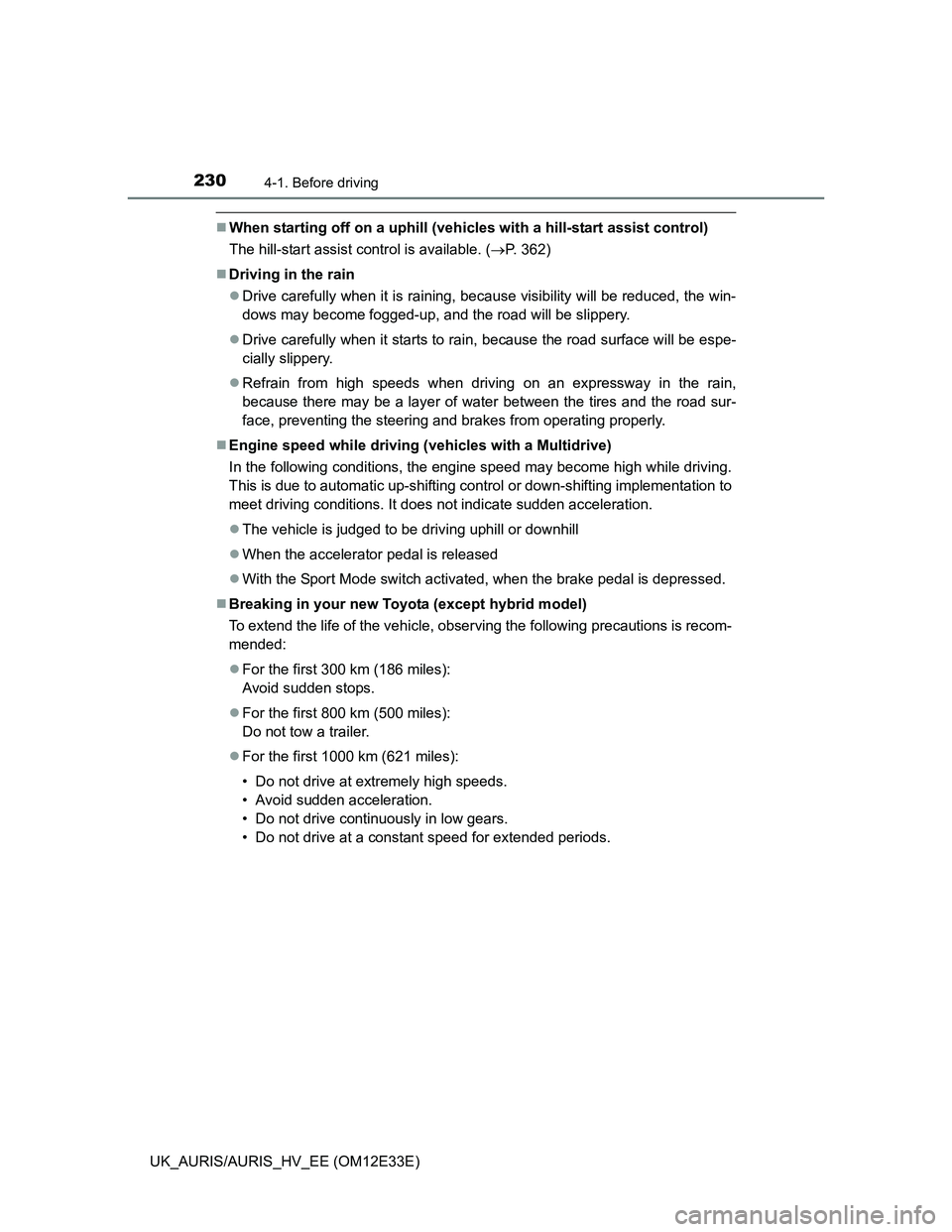
2304-1. Before driving
UK_AURIS/AURIS_HV_EE (OM12E33E)
When starting off on a uphill (vehicles with a hill-start assist control)
The hill-start assist control is available. (P. 362)
Driving in the rain
Drive carefully when it is raining, because visibility will be reduced, the win-
dows may become fogged-up, and the road will be slippery.
Drive carefully when it starts to rain, because the road surface will be espe-
cially slippery.
Refrain from high speeds when driving on an expressway in the rain,
because there may be a layer of water between the tires and the road sur-
face, preventing the steering and brakes from operating properly.
Engine speed while driving (vehicles with a Multidrive)
In the following conditions, the engine speed may become high while driving.
This is due to automatic up-shifting control or down-shifting implementation to
meet driving conditions. It does not indicate sudden acceleration.
The vehicle is judged to be driving uphill or downhill
When the accelerator pedal is released
With the Sport Mode switch activated, when the brake pedal is depressed.
Breaking in your new Toyota (except hybrid model)
To extend the life of the vehicle, observing the following precautions is recom-
mended:
For the first 300 km (186 miles):
Avoid sudden stops.
For the first 800 km (500 miles):
Do not tow a trailer.
For the first 1000 km (621 miles):
• Do not drive at extremely high speeds.
• Avoid sudden acceleration.
• Do not drive continuously in low gears.
• Do not drive at a constant speed for extended periods.
Page 234 of 750
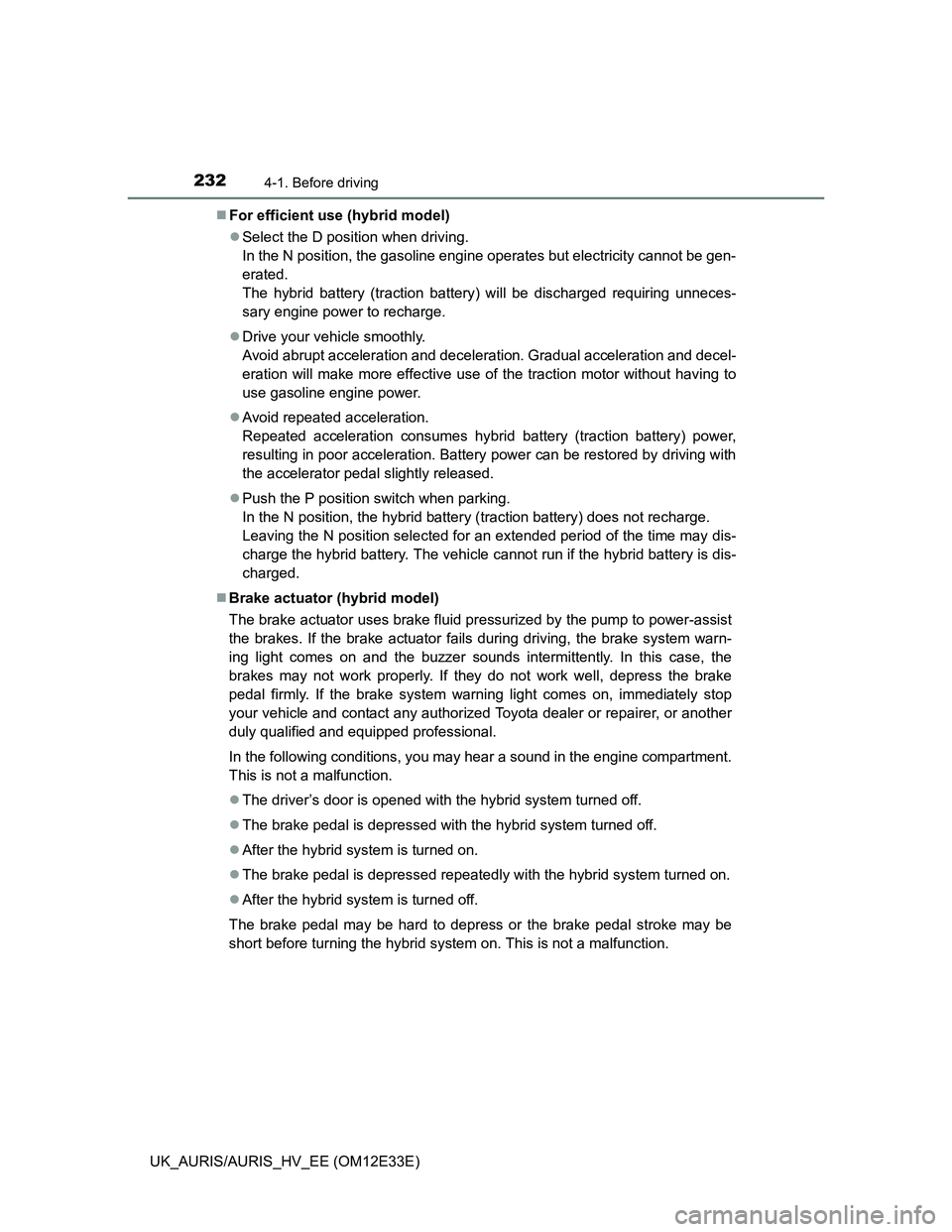
2324-1. Before driving
UK_AURIS/AURIS_HV_EE (OM12E33E)For efficient use (hybrid model)
Select the D position when driving.
In the N position, the gasoline engine operates but electricity cannot be gen-
erated.
The hybrid battery (traction battery) will be discharged requiring unneces-
sary engine power to recharge.
Drive your vehicle smoothly.
Avoid abrupt acceleration and deceleration. Gradual acceleration and decel-
eration will make more effective use of the traction motor without having to
use gasoline engine power.
Avoid repeated acceleration.
Repeated acceleration consumes hybrid battery (traction battery) power,
resulting in poor acceleration. Battery power can be restored by driving with
the accelerator pedal slightly released.
Push the P position switch when parking.
In the N position, the hybrid battery (traction battery) does not recharge.
Leaving the N position selected for an extended period of the time may dis-
charge the hybrid battery. The vehicle cannot run if the hybrid battery is dis-
charged.
Brake actuator (hybrid model)
The brake actuator uses brake fluid pressurized by the pump to power-assist
the brakes. If the brake actuator fails during driving, the brake system warn-
ing light comes on and the buzzer sounds intermittently. In this case, the
brakes may not work properly. If they do not work well, depress the brake
pedal firmly. If the brake system warning light comes on, immediately stop
your vehicle and contact any authorized Toyota dealer or repairer, or another
duly qualified and equipped professional.
In the following conditions, you may hear a sound in the engine compartment.
This is not a malfunction.
The driver’s door is opened with the hybrid system turned off.
The brake pedal is depressed with the hybrid system turned off.
After the hybrid system is turned on.
The brake pedal is depressed repeatedly with the hybrid system turned on.
After the hybrid system is turned off.
The brake pedal may be hard to depress or the brake pedal stroke may be
short before turning the hybrid system on. This is not a malfunction.
Page 235 of 750
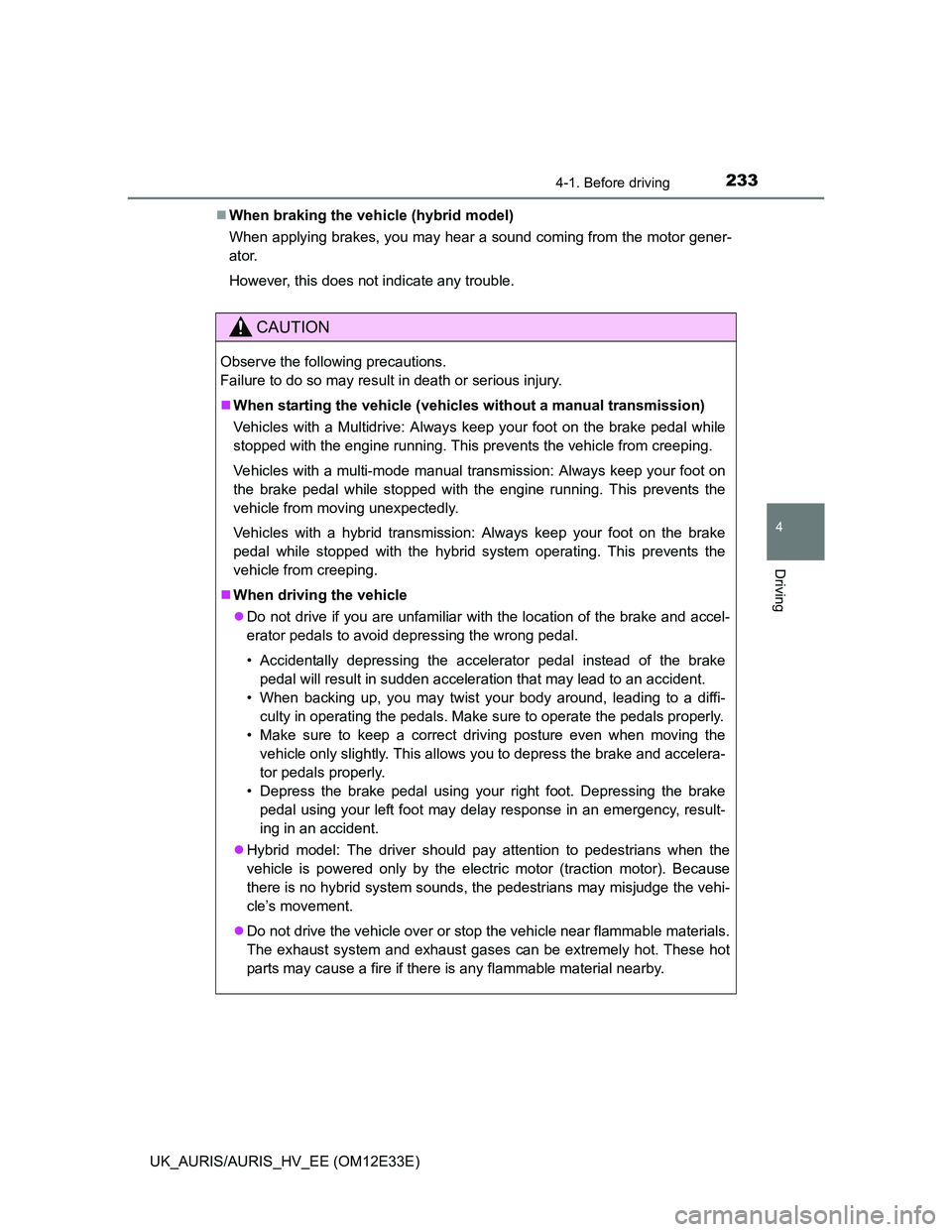
2334-1. Before driving
UK_AURIS/AURIS_HV_EE (OM12E33E)
4
Driving
When braking the vehicle (hybrid model)
When applying brakes, you may hear a sound coming from the motor gener-
ator.
However, this does not indicate any trouble.
CAUTION
Observe the following precautions.
Failure to do so may result in death or serious injury.
When starting the vehicle (vehicles without a manual transmission)
Vehicles with a Multidrive: Always keep your foot on the brake pedal while
stopped with the engine running. This prevents the vehicle from creeping.
Vehicles with a multi-mode manual transmission: Always keep your foot on
the brake pedal while stopped with the engine running. This prevents the
vehicle from moving unexpectedly.
Vehicles with a hybrid transmission: Always keep your foot on the brake
pedal while stopped with the hybrid system operating. This prevents the
vehicle from creeping.
When driving the vehicle
Do not drive if you are unfamiliar with the location of the brake and accel-
erator pedals to avoid depressing the wrong pedal.
• Accidentally depressing the accelerator pedal instead of the brake
pedal will result in sudden acceleration that may lead to an accident.
• When backing up, you may twist your body around, leading to a diffi-
culty in operating the pedals. Make sure to operate the pedals properly.
• Make sure to keep a correct driving posture even when moving the
vehicle only slightly. This allows you to depress the brake and accelera-
tor pedals properly.
• Depress the brake pedal using your right foot. Depressing the brake
pedal using your left foot may delay response in an emergency, result-
ing in an accident.
Hybrid model: The driver should pay attention to pedestrians when the
vehicle is powered only by the electric motor (traction motor). Because
there is no hybrid system sounds, the pedestrians may misjudge the vehi-
cle’s movement.
Do not drive the vehicle over or stop the vehicle near flammable materials.
The exhaust system and exhaust gases can be extremely hot. These hot
parts may cause a fire if there is any flammable material nearby.
Page 236 of 750
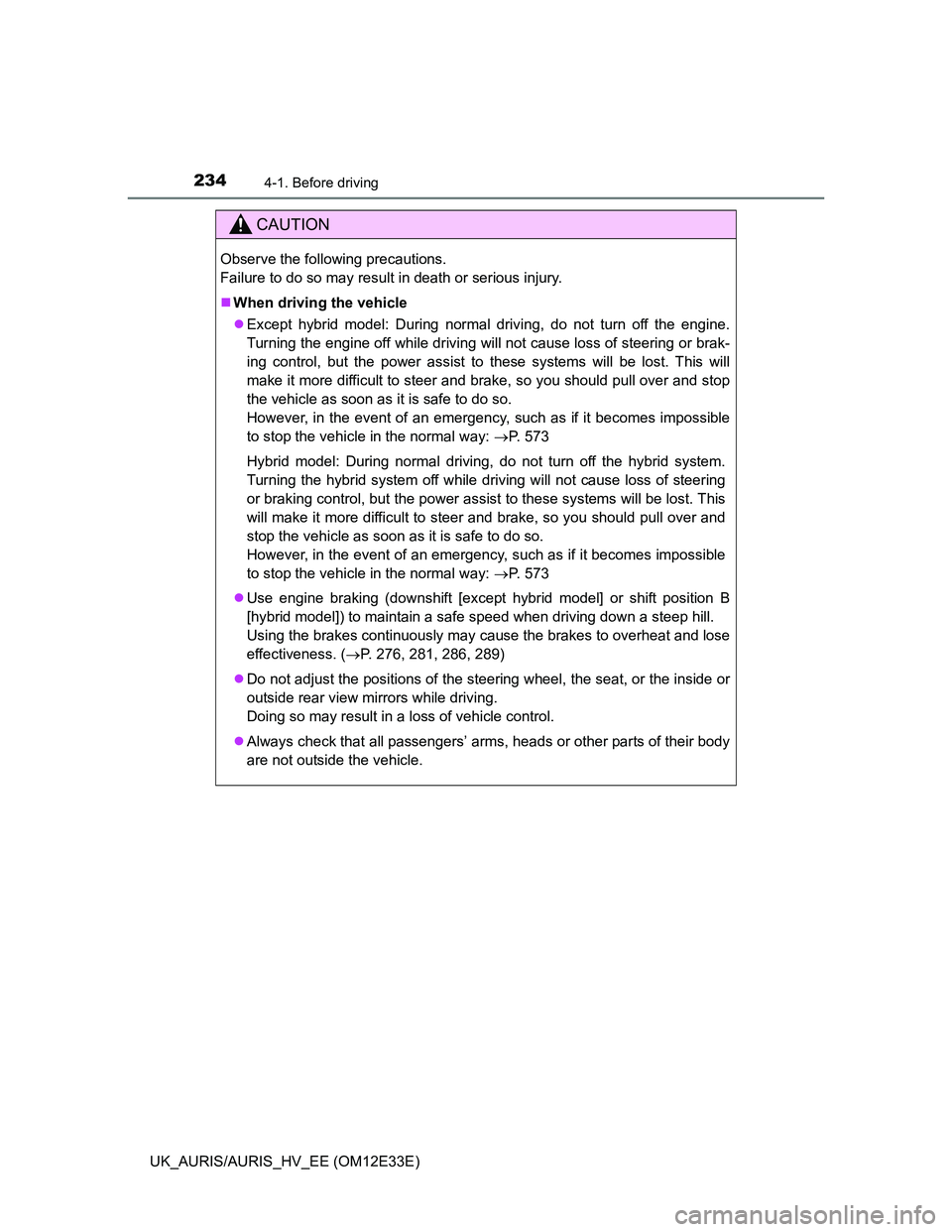
2344-1. Before driving
UK_AURIS/AURIS_HV_EE (OM12E33E)
CAUTION
Observe the following precautions.
Failure to do so may result in death or serious injury.
When driving the vehicle
Except hybrid model: During normal driving, do not turn off the engine.
Turning the engine off while driving will not cause loss of steering or brak-
ing control, but the power assist to these systems will be lost. This will
make it more difficult to steer and brake, so you should pull over and stop
the vehicle as soon as it is safe to do so.
However, in the event of an emergency, such as if it becomes impossible
to stop the vehicle in the normal way: P. 573
Hybrid model: During normal driving, do not turn off the hybrid system.
Turning the hybrid system off while driving will not cause loss of steering
or braking control, but the power assist to these systems will be lost. This
will make it more difficult to steer and brake, so you should pull over and
stop the vehicle as soon as it is safe to do so.
However, in the event of an emergency, such as if it becomes impossible
to stop the vehicle in the normal way: P. 573
Use engine braking (downshift [except hybrid model] or shift position B
[hybrid model]) to maintain a safe speed when driving down a steep hill.
Using the brakes continuously may cause the brakes to overheat and lose
effectiveness. (P. 276, 281, 286, 289)
Do not adjust the positions of the steering wheel, the seat, or the inside or
outside rear view mirrors while driving.
Doing so may result in a loss of vehicle control.
Always check that all passengers’ arms, heads or other parts of their body
are not outside the vehicle.
Page 237 of 750
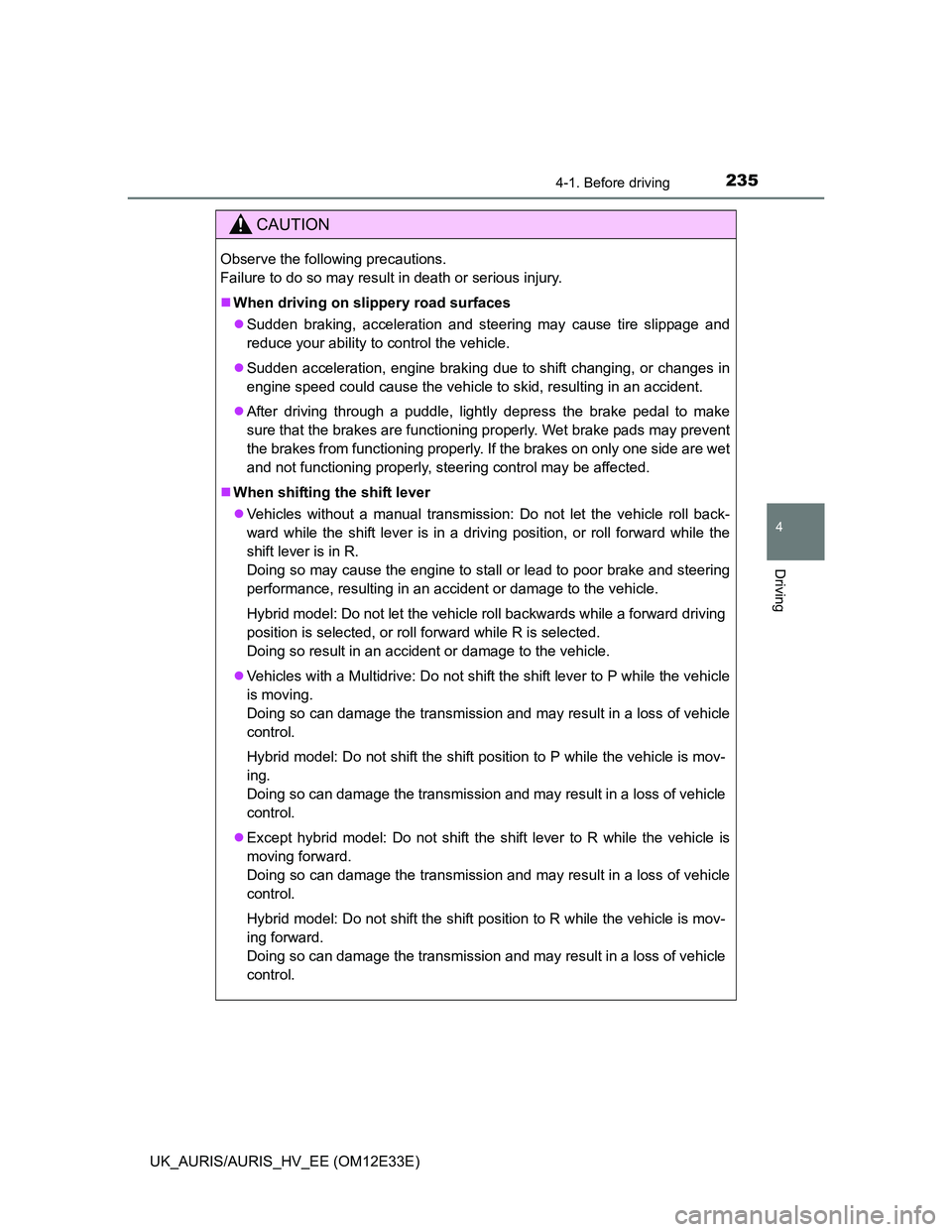
2354-1. Before driving
UK_AURIS/AURIS_HV_EE (OM12E33E)
4
Driving
CAUTION
Observe the following precautions.
Failure to do so may result in death or serious injury.
When driving on slippery road surfaces
Sudden braking, acceleration and steering may cause tire slippage and
reduce your ability to control the vehicle.
Sudden acceleration, engine braking due to shift changing, or changes in
engine speed could cause the vehicle to skid, resulting in an accident.
After driving through a puddle, lightly depress the brake pedal to make
sure that the brakes are functioning properly. Wet brake pads may prevent
the brakes from functioning properly. If the brakes on only one side are wet
and not functioning properly, steering control may be affected.
When shifting the shift lever
Vehicles without a manual transmission: Do not let the vehicle roll back-
ward while the shift lever is in a driving position, or roll forward while the
shift lever is in R.
Doing so may cause the engine to stall or lead to poor brake and steering
performance, resulting in an accident or damage to the vehicle.
Hybrid model: Do not let the vehicle roll backwards while a forward driving
position is selected, or roll forward while R is selected.
Doing so result in an accident or damage to the vehicle.
Vehicles with a Multidrive: Do not shift the shift lever to P while the vehicle
is moving.
Doing so can damage the transmission and may result in a loss of vehicle
control.
Hybrid model: Do not shift the shift position to P while the vehicle is mov-
ing.
Doing so can damage the transmission and may result in a loss of vehicle
control.
Except hybrid model: Do not shift the shift lever to R while the vehicle is
moving forward.
Doing so can damage the transmission and may result in a loss of vehicle
control.
Hybrid model: Do not shift the shift position to R while the vehicle is mov-
ing forward.
Doing so can damage the transmission and may result in a loss of vehicle
control.
Page 241 of 750
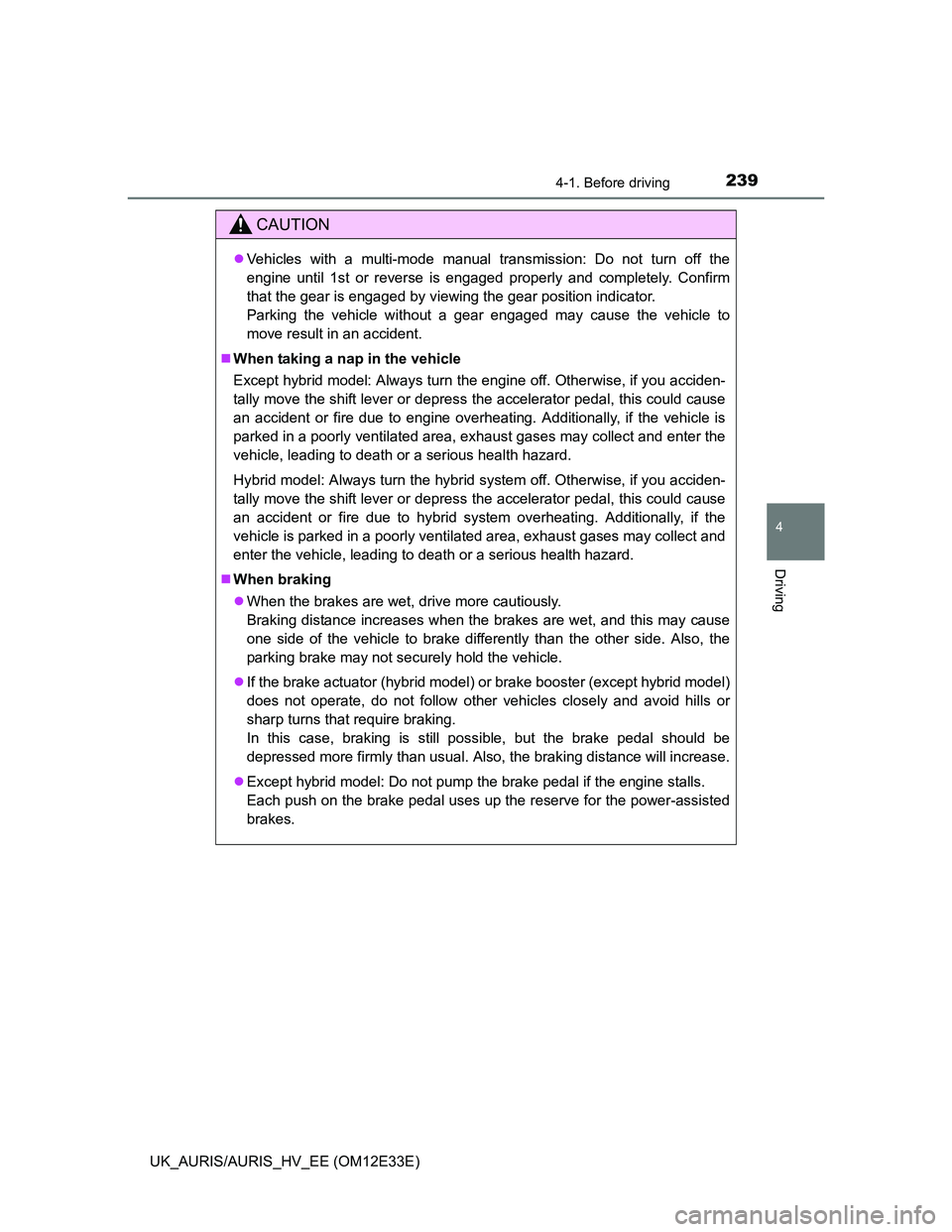
2394-1. Before driving
UK_AURIS/AURIS_HV_EE (OM12E33E)
4
Driving
CAUTION
Vehicles with a multi-mode manual transmission: Do not turn off the
engine until 1st or reverse is engaged properly and completely. Confirm
that the gear is engaged by viewing the gear position indicator.
Parking the vehicle without a gear engaged may cause the vehicle to
move result in an accident.
When taking a nap in the vehicle
Except hybrid model: Always turn the engine off. Otherwise, if you acciden-
tally move the shift lever or depress the accelerator pedal, this could cause
an accident or fire due to engine overheating. Additionally, if the vehicle is
parked in a poorly ventilated area, exhaust gases may collect and enter the
vehicle, leading to death or a serious health hazard.
Hybrid model: Always turn the hybrid system off. Otherwise, if you acciden-
tally move the shift lever or depress the accelerator pedal, this could cause
an accident or fire due to hybrid system overheating. Additionally, if the
vehicle is parked in a poorly ventilated area, exhaust gases may collect and
enter the vehicle, leading to death or a serious health hazard.
When braking
When the brakes are wet, drive more cautiously.
Braking distance increases when the brakes are wet, and this may cause
one side of the vehicle to brake differently than the other side. Also, the
parking brake may not securely hold the vehicle.
If the brake actuator (hybrid model) or brake booster (except hybrid model)
does not operate, do not follow other vehicles closely and avoid hills or
sharp turns that require braking.
In this case, braking is still possible, but the brake pedal should be
depressed more firmly than usual. Also, the braking distance will increase.
Except hybrid model: Do not pump the brake pedal if the engine stalls.
Each push on the brake pedal uses up the reserve for the power-assisted
brakes.
Page 242 of 750
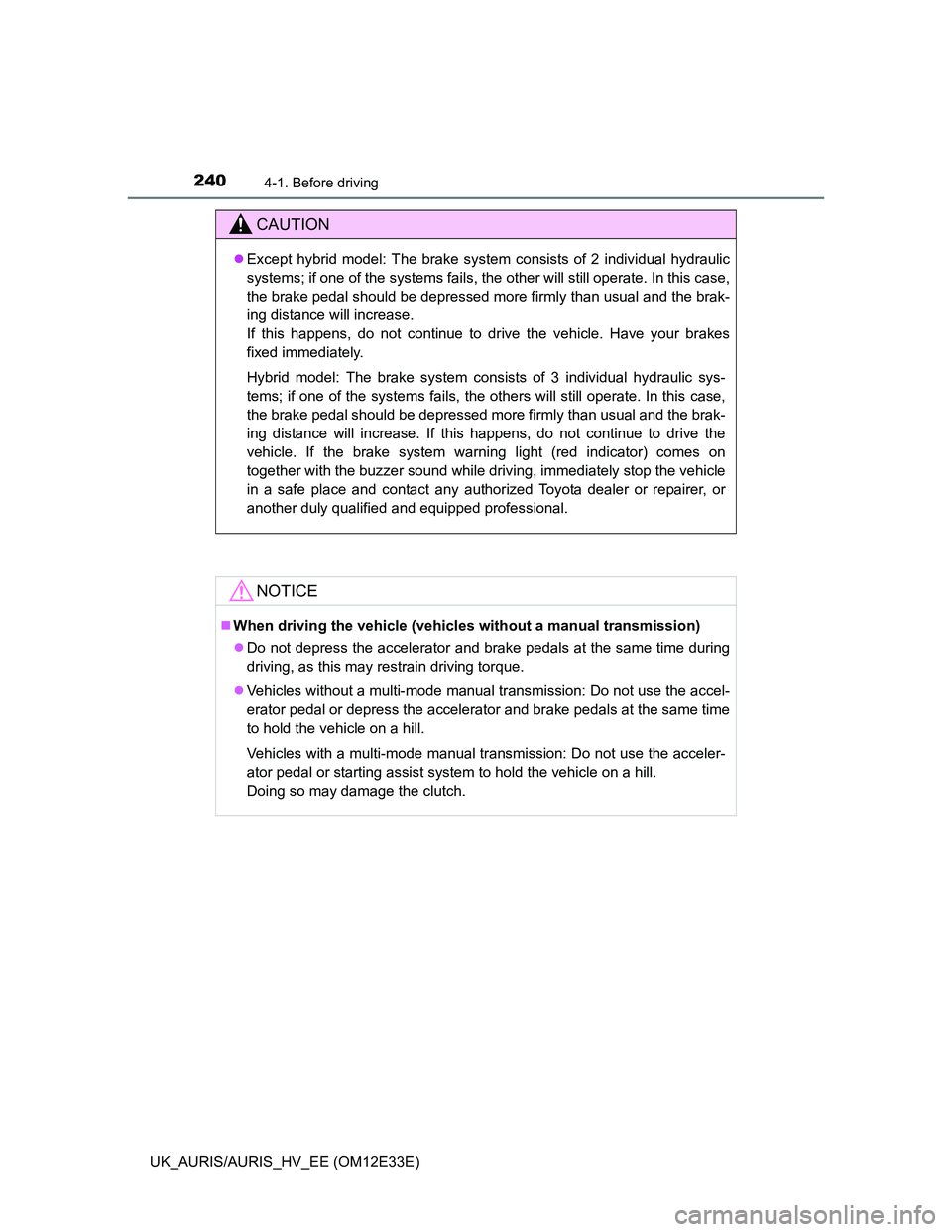
2404-1. Before driving
UK_AURIS/AURIS_HV_EE (OM12E33E)
CAUTION
Except hybrid model: The brake system consists of 2 individual hydraulic
systems; if one of the systems fails, the other will still operate. In this case,
the brake pedal should be depressed more firmly than usual and the brak-
ing distance will increase.
If this happens, do not continue to drive the vehicle. Have your brakes
fixed immediately.
Hybrid model: The brake system consists of 3 individual hydraulic sys-
tems; if one of the systems fails, the others will still operate. In this case,
the brake pedal should be depressed more firmly than usual and the brak-
ing distance will increase. If this happens, do not continue to drive the
vehicle. If the brake system warning light (red indicator) comes on
together with the buzzer sound while driving, immediately stop the vehicle
in a safe place and contact any authorized Toyota dealer or repairer, or
another duly qualified and equipped professional.
NOTICE
When driving the vehicle (vehicles without a manual transmission)
Do not depress the accelerator and brake pedals at the same time during
driving, as this may restrain driving torque.
Vehicles without a multi-mode manual transmission: Do not use the accel-
erator pedal or depress the accelerator and brake pedals at the same time
to hold the vehicle on a hill.
Vehicles with a multi-mode manual transmission: Do not use the acceler-
ator pedal or starting assist system to hold the vehicle on a hill.
Doing so may damage the clutch.
Page 253 of 750
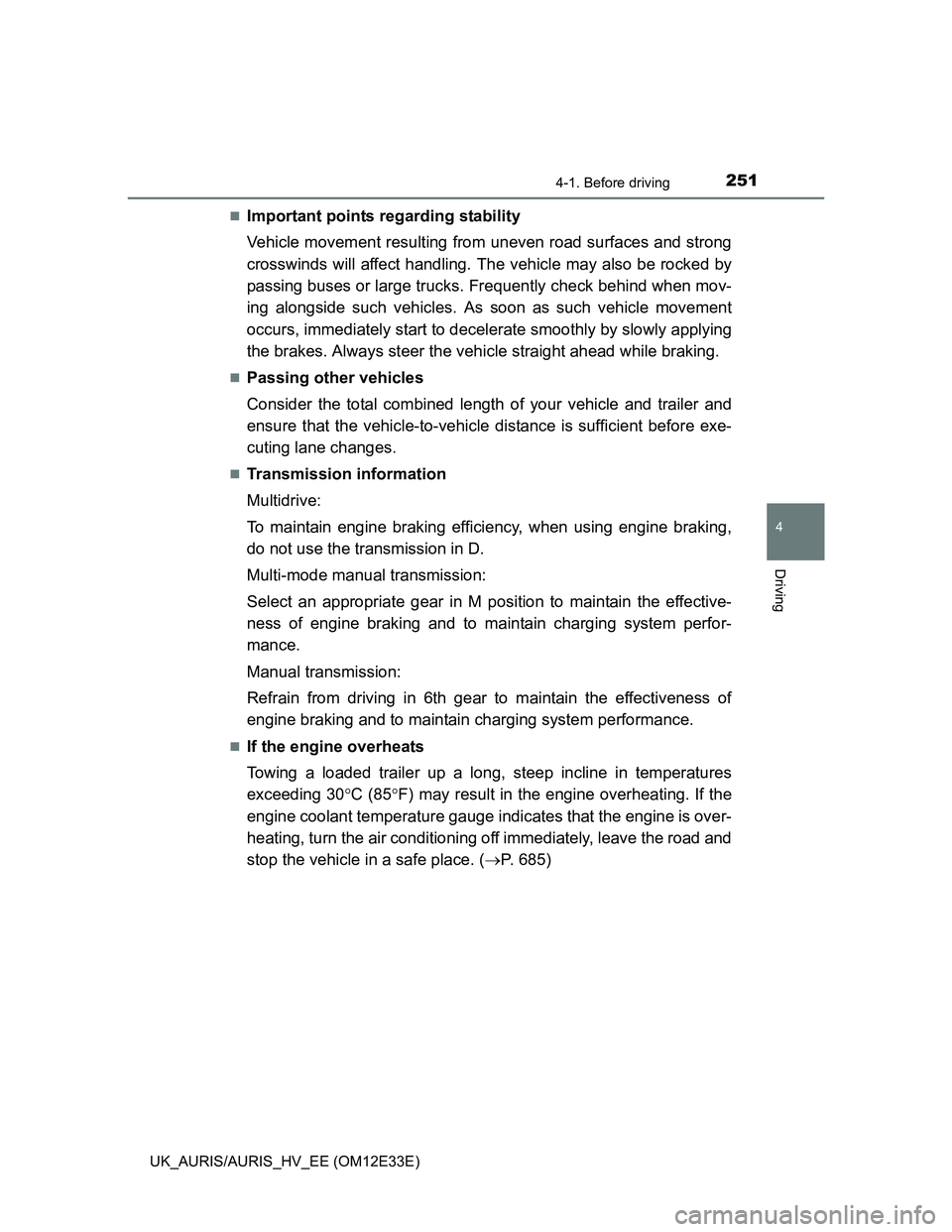
2514-1. Before driving
UK_AURIS/AURIS_HV_EE (OM12E33E)
4
Driving
Important points regarding stability
Vehicle movement resulting from uneven road surfaces and strong
crosswinds will affect handling. The vehicle may also be rocked by
passing buses or large trucks. Frequently check behind when mov-
ing alongside such vehicles. As soon as such vehicle movement
occurs, immediately start to decelerate smoothly by slowly applying
the brakes. Always steer the vehicle straight ahead while braking.
Passing other vehicles
Consider the total combined length of your vehicle and trailer and
ensure that the vehicle-to-vehicle distance is sufficient before exe-
cuting lane changes.
Transmission information
Multidrive:
To maintain engine braking efficiency, when using engine braking,
do not use the transmission in D.
Multi-mode manual transmission:
Select an appropriate gear in M position to maintain the effective-
ness of engine braking and to maintain charging system perfor-
mance.
Manual transmission:
Refrain from driving in 6th gear to maintain the effectiveness of
engine braking and to maintain charging system performance.
If the engine overheats
Towing a loaded trailer up a long, steep incline in temperatures
exceeding 30C (85F) may result in the engine overheating. If the
engine coolant temperature gauge indicates that the engine is over-
heating, turn the air conditioning off immediately, leave the road and
stop the vehicle in a safe place. (P. 685)
Page 326 of 750
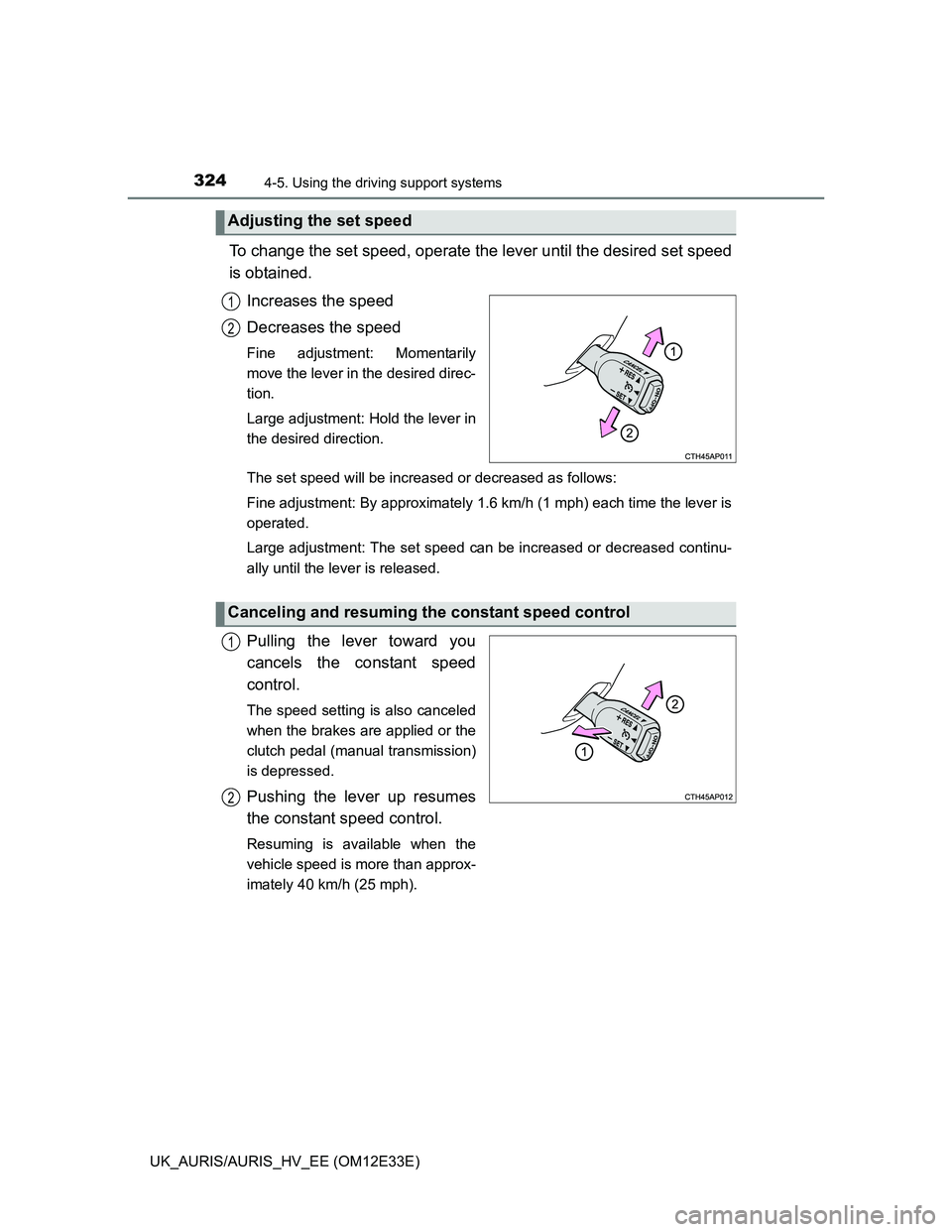
3244-5. Using the driving support systems
UK_AURIS/AURIS_HV_EE (OM12E33E)
To change the set speed, operate the lever until the desired set speed
is obtained.
Increases the speed
Decreases the speed
Fine adjustment: Momentarily
move the lever in the desired direc-
tion.
Large adjustment: Hold the lever in
the desired direction.
The set speed will be increased or decreased as follows:
Fine adjustment: By approximately 1.6 km/h (1 mph) each time the lever is
operated.
Large adjustment: The set speed can be increased or decreased continu-
ally until the lever is released.
Pulling the lever toward you
cancels the constant speed
control.
The speed setting is also canceled
when the brakes are applied or the
clutch pedal (manual transmission)
is depressed.
Pushing the lever up resumes
the constant speed control.
Resuming is available when the
vehicle speed is more than approx-
imately 40 km/h (25 mph).
Adjusting the set speed
1
2
Canceling and resuming the constant speed control
1
2
Page 336 of 750
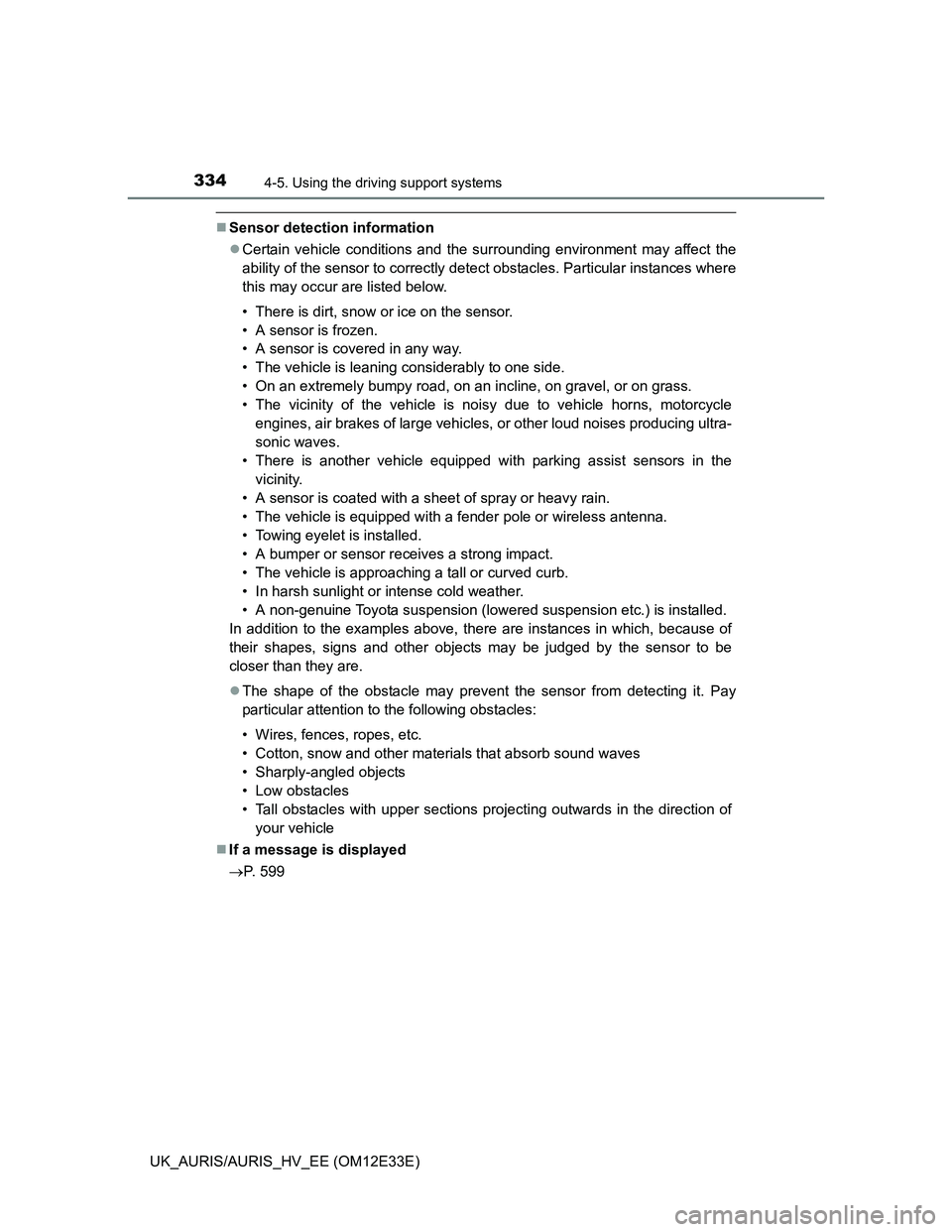
3344-5. Using the driving support systems
UK_AURIS/AURIS_HV_EE (OM12E33E)
Sensor detection information
Certain vehicle conditions and the surrounding environment may affect the
ability of the sensor to correctly detect obstacles. Particular instances where
this may occur are listed below.
• There is dirt, snow or ice on the sensor.
• A sensor is frozen.
• A sensor is covered in any way.
• The vehicle is leaning considerably to one side.
• On an extremely bumpy road, on an incline, on gravel, or on grass.
• The vicinity of the vehicle is noisy due to vehicle horns, motorcycle
engines, air brakes of large vehicles, or other loud noises producing ultra-
sonic waves.
• There is another vehicle equipped with parking assist sensors in the
vicinity.
• A sensor is coated with a sheet of spray or heavy rain.
• The vehicle is equipped with a fender pole or wireless antenna.
• Towing eyelet is installed.
• A bumper or sensor receives a strong impact.
• The vehicle is approaching a tall or curved curb.
• In harsh sunlight or intense cold weather.
• A non-genuine Toyota suspension (lowered suspension etc.) is installed.
In addition to the examples above, there are instances in which, because of
their shapes, signs and other objects may be judged by the sensor to be
closer than they are.
The shape of the obstacle may prevent the sensor from detecting it. Pay
particular attention to the following obstacles:
• Wires, fences, ropes, etc.
• Cotton, snow and other materials that absorb sound waves
• Sharply-angled objects
• Low obstacles
• Tall obstacles with upper sections projecting outwards in the direction of
your vehicle
If a message is displayed
P. 599